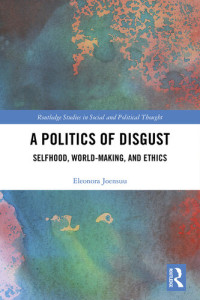
A Politics of Disgust
Eleonora Joensuu,
Introduction: everyday encounters This chapter begins by tracing out some of the experiences that brought the author to the study of disgust. The chapter highlights curious, demanding, and puzzling aspects of disgust such as disgust's dual nature of repulsion and fascination, its paradoxical and ambiguous nature, as well as its relationship to questions of morality and ethics. This chapter introduces the reader to the approach this text takes, which is to ask "what does disgust do?" and to the argument that disgust is active in creating meaning about the self, others, and the world. Lastly, this chapter invites the reader to consider their own disgust as a method for reading. 1 Mapping the terrain: approaches to disgust in Western psychology and thought This chapter provides a limited survey of how disgust is currently understood in psychological research and in the humanities literature. The aim is not to define disgust conclusively, but to indicate some of the general themes that have arisen across disgust research. This is intended to situate the reader in the field of disgust studies. This chapter begins by examining research in psychology that constitutes some of the earliest disgust research; it thereby gives a sense of how conceptualizations of disgust have developed and changed over time. Following this, the chapter turns to a thematic analysis that incorporates research from both psychology and the humanities. Rather than examining existing disgust research along strict disciplinary distinctions, the discussion works through prominent themes, such as the presence of threat, fascination, and disgust's moral and ethical stakes. This chapter highlights that much of the current research is unable to address pressing questions in disgust-disgust's relevance to processes of selfhood, world-making, and ethics. 2 Towards a feminist politics of disgust: exposing the social, cultural, and theoretical "lenses" of disgust discourse This chapter takes up feminist perspectives to analyze some of the social, cultural, and intellectual contexts that have shaped current approaches to disgust. In particular, the chapter demonstrates that mind/body dualism, especially in its Cartesian form, as well as Western traditions of individualism, and patriarchal power structures have been significant in shaping conceptions of subjectivity and emotion broadly, and disgust specifically. Though feminist critiques of these areas are well established and some of the literature is two decades old, they have not been applied to the study of disgust specifically, especially not to the study of disgust as it relates to subjectivity. This chapter serves not only to account for the contexts shaping existing disgust accounts, but also to situate an alternative approach to disgust research. In other words, one cannot develop a different approach without understanding why and how current conceptualizations of disgust have come to be. Accordingly, the chapter proposes that a feminist politics of disgust offers an alternative approach to analyzing disgust. 3 A feminist politics of disgust: Jessica Benjamin, recognition, and reframing disgust This chapter takes up Jessica Benjamin's theory of recognition to reframe disgust experiences as intersubjective processes in which selfhood is struggled for and meaning-making happens. The chapter moves through an exposition of the central aspects of Benjamin's approach to recognition, including an overview of Benjamin's work in relationship to G. W. F Hegel's masterslave dialectic. From this, the chapter analyzes disgust as a struggle for recognition. The chapter demonstrates that by reframing disgust via the concept of recognition, it becomes possible to analyze disgust as a subjectsubject encounter. It thereby becomes conceivable to imagine more than one active subject in the encounter. In this reformulation, even those that that are named "disgusting object" can be understood as active subjects in a disgust encounter. Accordingly, this chapter also explores the position of the "disgusting" subject by using Jean-Paul Sartre's work on the concept of the look to analyze this position. In particular, the discussion examines the impact that a "look of disgust" could have on a subject to ask-"What does being seen as disgusting mean for me?" The author suggests that what the look of disgust reveals is that I do not only exist "for-myself," but also "for-the-other." 4 Meeting the ethical demands of disgust as the struggle for recognition Chapter 4 builds on the reframing of disgust as a struggle for recognition laid out in the previous chapter towards a reimagining of disgust's ethical question and implications. The question at the heart of this chapter is, how ought I to treat an other when they disgust me? Through a series of invitations, this chapter offers the reader opportunities to examine their own disgust-both repulsion and fascination-to play with different ways of thinking through their disgust and the disgust of others. These direct invitations-to play, to sustain paradox, to locate monstrosity-are rooted in the chapter's central argument that to meet disgust's ethical demands requires a relational process; such a process cannot be attained in isolation, but in being with. The aim of this chapter is to create space both conceptually and tangibly for what Jessica Benjamin calls "thirdness" in order to begin imagining and enacting our ethical responsibilities in the face of disgust. Along these lines, the chapter argues that our theorizing of disgust must act as a witness so that the effects, impacts, and potential harms of disgust-on selfhood, intersubjective relations, and world-making-can be acknowledged. 5 The work of disgust: the Ashley Smith case Chapter 5 is dedicated to a case study of Ashley Smith's imprisonment and death in light of the approach to disgust developed in previous chapters. Ashley Smith died in 2007 while in federal custody at the Grand Valley Institution for Women (GVI-W) in Kitchener-Waterloo, Ontario, Canada. She died from self-inflicted strangulation while correctional officers watched. The officers had been ordered not to enter her cell in part because of the history of "disgusting" incidents wherein Ashley would smear feces, throw urine, and spit. The analysis in this chapter signals at what repulsion and fascination can signify when disgust is configured as a meeting of two subjects, rather than a meeting between a disgusted subject and a disgusting object. The chapter argues that the disgust encounters that unfolded between Ashley and the penal institution were more significant than what may initially be assumed-they contributed to the circumstances that led to her death. This significance becomes evident when the disgust encounters that unfolded between Ashley and the institution are analyzed from a relational framework via Benjamin, and as encounters that were relevant to processes of selfhood and meaning-making. The chapter considers what implications an examination of disgust in Ashley's imprisonment and death may have for institutional policies and practices more generally. Conclusion: matters of disgust The Conclusion outlines the key contributions of the overall work in answering its central question: what does disgust do in the world? In particular, the Conclusion considers the ways in which the text exposes the work of disgust, especially in the ways that it expands accounts of repulsion and fascination without prioritizing one over the other and without dismissing fascination as an oddity. Second, this chapter outlines how this work has contributed to an understanding of disgust's ethical demands, especially in imagining how these demands may be met in liveable and realistic ways. The chapter highlights that disgust encounters are a constitutive element of how we understand ourselves, others, and the world. In short, disgust is about meaning-making. Accordingly, this chapter argues that expanding the conceptual and tangible resources we have around disgust is relevant not only for how disgust can be experienced, but also for the ways in which we live our daily lives, especially among and with other living, feeling, thinking subjects in the world.
Yıl:
2020
Yayımcı:
Taylor & Francis (CAM)
Dil:
english
ISBN 10:
0429574975
ISBN 13:
9780429574979
Dosya:
EPUB, 746 KB
IPFS:
,
english, 2020
 Amazon
Amazon  Barnes & Noble
Barnes & Noble  Bookshop.org
Bookshop.org  Dosyaları dönüştürün
Dosyaları dönüştürün Diğer arama sonuçları
Diğer arama sonuçları Diğer avantajları
Diğer avantajları 






